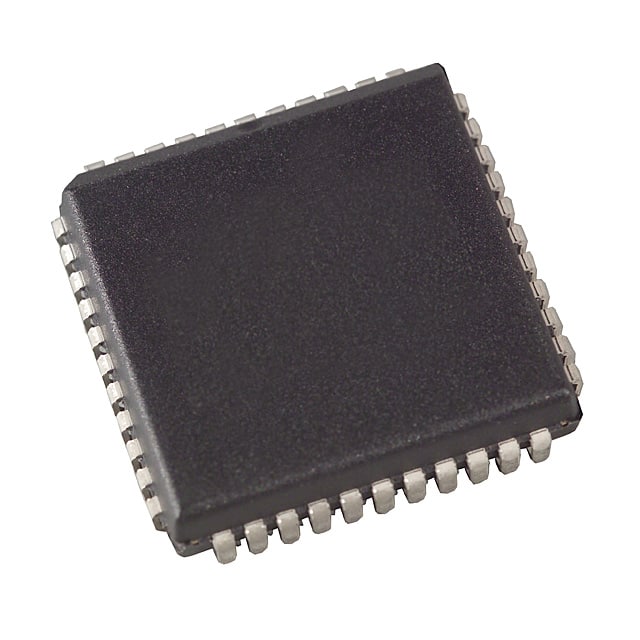Xem thông số kỹ thuật để biết chi tiết sản phẩm.

W78L052C24PL
Product Overview
- Category: Integrated Circuit (IC)
- Use: Microcontroller
- Characteristics: Low-power, 8-bit, 8051-compatible
- Package: PLCC (Plastic Leaded Chip Carrier)
- Essence: High-performance microcontroller with low power consumption
- Packaging/Quantity: Available in tape and reel packaging, quantity varies based on supplier
Specifications
- Architecture: 8-bit
- CPU Speed: Up to 12 MHz
- Program Memory: 4 KB
- Data Memory: 256 bytes
- I/O Pins: 24
- Operating Voltage: 2.7V - 5.5V
- Operating Temperature: -40°C to +85°C
Detailed Pin Configuration
The W78L052C24PL microcontroller has a total of 44 pins. The pin configuration is as follows:
- P0.0
- P0.1
- P0.2
- P0.3
- P0.4
- P0.5
- P0.6
- P0.7
- VSS (Ground)
- RST
- PSEN
- ALE
- EA/VPP
- P2.0
- P2.1
- P2.2
- P2.3
- P2.4
- P2.5
- P2.6
- P2.7
- P3.0
- P3.1
- P3.2
- P3.3
- P3.4
- P3.5
- P3.6
- P3.7
- XTAL1
- XTAL2
- VDD (Power)
Functional Features
- 8051-compatible microcontroller with enhanced features
- Low-power consumption for energy-efficient applications
- High-performance CPU with up to 12 MHz clock speed
- On-chip program memory and data memory for efficient data storage
- Multiple I/O pins for interfacing with external devices
- Built-in reset circuitry for reliable system initialization
- Support for external crystal oscillator for accurate timing
Advantages and Disadvantages
Advantages: - Compatibility with the popular 8051 architecture allows easy migration of existing designs - Low-power consumption makes it suitable for battery-powered applications - High-performance CPU enables fast execution of instructions - Sufficient program and data memory for most embedded applications - Versatile I/O pins provide flexibility in connecting peripherals
Disadvantages: - Limited program memory size may restrict the complexity of applications - Relatively small data memory may require external storage for larger datasets - PLCC package may not be suitable for all PCB layouts or assembly processes
Working Principles
The W78L052C24PL microcontroller operates based on the principles of the 8051 architecture. It executes instructions stored in its program memory, interacts with external devices through its I/O pins, and utilizes its on-chip resources to perform various tasks. The microcontroller's CPU fetches instructions from program memory, decodes them, and executes the corresponding operations. It can communicate with other devices using standard communication protocols such as UART, SPI, or I2C.
Detailed Application Field Plans
The W78L052C24PL microcontroller finds applications in various fields, including but not limited to:
- Home automation systems
- Industrial control systems
- Automotive electronics
- Consumer electronics
- Internet of Things (IoT) devices
- Medical devices
- Robotics
Detailed and Complete Alternative Models
- W78E052C40PL - Similar microcontroller with higher program memory capacity (40 KB)
- W78L052D24PL - Low-power variant with reduced operating voltage range (1.8V - 3.6V)
- W78L052C18PL - Lower pin count version with 18 I/O pins
- W78L052C24DL - Dual supply voltage variant with extended temperature range (-40°C to +105°C)
(Note: The above alternative models are just examples and not an exhaustive list.)
This encyclopedia entry provides an overview of the W78L052C24PL microcontroller, including its product details, specifications, pin configuration, functional features, advantages, disadvantages, working principles, application field plans, and alternative models.
Liệt kê 10 câu hỏi và câu trả lời thường gặp liên quan đến ứng dụng W78L052C24PL trong giải pháp kỹ thuật
Sure! Here are 10 common questions and answers related to the application of W78L052C24PL in technical solutions:
Q: What is W78L052C24PL? A: W78L052C24PL is a microcontroller chip designed for embedded systems and technical applications.
Q: What are the key features of W78L052C24PL? A: Some key features include 8-bit CPU, 4KB of flash memory, 256 bytes of RAM, multiple I/O ports, and built-in timers.
Q: What are the typical applications of W78L052C24PL? A: W78L052C24PL is commonly used in various technical solutions such as industrial automation, consumer electronics, home appliances, and automotive systems.
Q: Can W78L052C24PL be programmed using C language? A: Yes, W78L052C24PL can be programmed using C language along with the appropriate development tools and compilers.
Q: Does W78L052C24PL support communication protocols like UART or SPI? A: Yes, W78L052C24PL supports popular communication protocols like UART (Universal Asynchronous Receiver-Transmitter) and SPI (Serial Peripheral Interface).
Q: What is the maximum clock frequency supported by W78L052C24PL? A: The maximum clock frequency supported by W78L052C24PL is typically 12 MHz.
Q: Can W78L052C24PL operate on low power supply voltages? A: Yes, W78L052C24PL can operate on low power supply voltages ranging from 2.4V to 5.5V.
Q: Is W78L052C24PL suitable for battery-powered applications? A: Yes, W78L052C24PL is suitable for battery-powered applications due to its low power consumption and sleep modes.
Q: Can W78L052C24PL be used in real-time control systems? A: Yes, W78L052C24PL can be used in real-time control systems as it has built-in timers and interrupt capabilities.
Q: Are there any development boards or evaluation kits available for W78L052C24PL? A: Yes, there are development boards and evaluation kits available that provide a convenient platform for prototyping and testing with W78L052C24PL.
Please note that the specific details and answers may vary depending on the manufacturer's documentation and specifications of W78L052C24PL.

